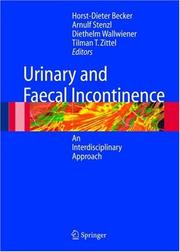| Listing 1 - 5 of 5 |
Sort by
|

ISBN: 1280234709 9786610234707 3540274944 3540222251 3642431968 Year: 2005 Publisher: Berlin ; New York : Springer,
Abstract | Keywords | Export | Availability | Bookmark
 Loading...
Loading...Choose an application
- Reference Manager
- EndNote
- RefWorks (Direct export to RefWorks)
The book gives a survey of the prevalence, the pathophysiology, the diagnosis, the state of the art treatment, both conservative and operative, and the long term results of urinary and faecal incontinence treatment. It is suited for general and colorectal surgeons, urologists, gynaecologists and gastroenterologists who treat incontinent patients.
Urinary incontinence. --- Fecal incontinence. --- Fecal soiling --- Feces --- Incontinence, Fecal --- Soiling, Fecal --- Defecation disorders --- Bladder control disorder --- Incontinence, Urinary --- Urine --- Urination disorders --- Incontinence --- Surgery. --- Colon (Anatomy) --- Urology. --- Gynecology. --- General Surgery. --- Colorectal Surgery. --- Medicine --- Genitourinary organs --- Gynaecology --- Generative organs, Female --- Surgery, Primitive --- Diseases --- Rectum—Surgery . --- Gynecology .
Book
ISBN: 3540171169 Year: 1988 Publisher: Berlin Springer
Abstract | Keywords | Export | Availability | Bookmark
 Loading...
Loading...Choose an application
- Reference Manager
- EndNote
- RefWorks (Direct export to RefWorks)
Digital
ISBN: 9783540274940 Year: 2005 Publisher: Berlin, Heidelberg Springer-Verlag Berlin Heidelberg
Abstract | Keywords | Export | Availability | Bookmark
 Loading...
Loading...Choose an application
- Reference Manager
- EndNote
- RefWorks (Direct export to RefWorks)
Urology. Andrology --- Surgery --- Gynaecology. Obstetrics --- urologie --- chirurgie --- gynaecologie --- vroedkunde
Book
ISBN: 3893083251 Year: 2001 Publisher: Tübingen Attempto
Abstract | Keywords | Export | Availability | Bookmark
 Loading...
Loading...Choose an application
- Reference Manager
- EndNote
- RefWorks (Direct export to RefWorks)
Book
ISBN: 9783540274940 Year: 2005 Publisher: Berlin, Heidelberg Springer-Verlag Berlin Heidelberg
Abstract | Keywords | Export | Availability | Bookmark
 Loading...
Loading...Choose an application
- Reference Manager
- EndNote
- RefWorks (Direct export to RefWorks)
Two recent reviews provide perspective on the prevalence of faecal incontinence.M- ibag et al.(2003) suggest a range of 1%-11% in population-based studies and 4%-50% 2 in other,mainly clinic-based studies.Harrari (2002) suggests a range of 2%-18% in the community as distinct from 13%-54% in long-term care. The issues raised by these and other reviews (Tariq et al.2003) include a lack of definition of concepts and in- cators,inconsistent age and gender relationships,lack of information on social groups and differences in health-related risk factors identified.The aim of this paper is to - view all the evidence from population-based studies and thereby clarify the epide- ology of faecal incontinence. The search strategy included electronic search of Medline and Embase for English language papers concerning faecal incontinence'.Separate searches were carried out for prevalence' (1984-2003) and risk factors', correlates' or predictors' (1996-2003). Exclusion criteria for prevalence studies were: non-population-based; response rate of less than 60%; data collection from third parties; and lack of definition of faecal - continence as a whole and as distinct from anal incontinence.Studies concerning risk factors were excluded if they concerned selected groups (e.g.clinical series and lo- term care),local conditions affecting the pelvic floor (e.g.obstetric factors and c- cer), or children.All eligible studies were methodologically evaluated for potential biases.Information on prevalence and risk correspond to levels of evidence II-3 and II-2,respectively (Canadian Task Force on Preventive Care).
Urology. Andrology --- Surgery --- Gynaecology. Obstetrics --- urologie --- chirurgie --- gynaecologie --- vroedkunde
| Listing 1 - 5 of 5 |
Sort by
|

 Search
Search Feedback
Feedback About UniCat
About UniCat  Help
Help News
News